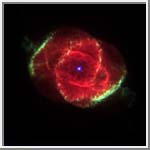 |
Deep Space Objects
|
Selected Deep Space Images
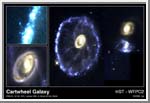 Cartwheel Galaxy
Cartwheel Galaxy
A rare and spectacular head-on collision between two galaxies
appears in this NASA Hubble Space Telescope true-color image of the
Cartwheel Galaxy, located 500 million light-years away in the
constellation Sculptor.
The striking ring-like feature is a direct result of a smaller intruder galaxy -- possibly one of two objects to the right of the ring -- that careened through the core of the host galaxy. Like a rock tossed into a lake, the collision sent a ripple of energy into space, plowing gas and dust in front of it. Expanding at 200,000 miles per hour, this cosmic tsunami leaves in its wake a firestorm of new star creation. Hubble resolves bright blue knots that are gigantic clusters of newborn stars and immense loops and bubbles blown into space by exploding stars (supernovae) going off like a string of firecrackers.
The Cartwheel Galaxy presumably was a normal spiral galaxy like our
Milky Way before the collision. This spiral structure is beginning to
re-emerge, as seen in the faint arms or spokes between the outer ring
and bulls-eye shaped nucleus. The ring contains at least several
billion new stars that would not normally have been created in such a
short time span and is so large (150,000 light-years across) our entire
Milky Way Galaxy would fit inside.
(Courtesy of Kirk Borne (STScI), and NASA)
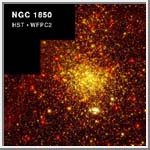 NGC1850 - Tale of Two Clusters
NGC1850 - Tale of Two Clusters
This image shows rich detail,
previously only seen in neighboring star birth regions, in a pair of
star clusters 166,000 light-years away in the Large Magellanic Cloud
(LMC), in the southern constellation Doradus.
HST's unique capabilities -- ultraviolet sensitivity, ability to see faint stars, and high resolution -- have been utilized fully to identify three separate populations in this concentration of nearly 10,000 stars down to the 25th magnitude (more that twice as many as can be seen over the entire sky with the naked eye on a clear night on Earth). The field of view is only 130 light-years across. Previous observations with ground-based telescopes resolve less than 1,000 stars in the same region. About 60 percent of the stars belong to the dominant yellow cluster called NGC 1850, which is estimated to be 50 million years old. A scattering of white stars in the image are massive stars that are only about 4 million years old and represent about 20 percent of the stars in the image. (The remainder are field stars in the LMC.) Besides being much younger, the white stars are much more loosely distributed than the yellow cluster. The significant difference between the two cluster ages suggests these are two separate star groups that lie along the same line of sight. The younger, more open cluster probably lies 200 light-years beyond the older cluster. If it were in the foreground, then dust contained in the white cluster would obscure stars in the older yellow cluster.
To observe two well-defined star populations separated by such a small gap of space is unusual. This juxtaposition suggests that supernova explosions in the older cluster might have triggered the birth of the younger cluster.
This color composite image is assembled from exposures taken in
ultraviolet, visible, and near-infrared light. Yellow stars correspond
to Main Sequence stars (like our Sun) with average surface temperatures
of 6000 Kelvin; red stars are cool giants and supergiants (3500 K); white
stars are hot young stars (25,000 K or more) that are bright in ultraviolet.
(Courtesy of R. Gilmozzi, STScI/ESA; Shawn Ewald, JPL; and NASA)
 Cat's Eye Nebula
Cat's Eye Nebula
This NASA Hubble Space Telescope image shows one of the most complex
planetary nebulae ever seen, NGC 6543, nicknamed the "Cat's Eye
Nebula." Hubble reveals surprisingly intricate structures including
concentric gas shells, jets of high-speed gas and unusual shock-induced
knots of gas. Estimated to be 1,000 years old, the nebula is a visual
"fossil record" of the dynamics and late evolution of a dying star.
A preliminary interpretation suggests that the star might be a double-star system. The dynamical effects of two stars orbiting one another most easily explains the intricate structures, which are much more complicated than features seen in most planetary nebulae. (The two stars are too close together to be individually resolved by Hubble, and instead, appear as a single point of light at the center of the nebula.)
According to this model, a fast "stellar wind" of gas blown off the central star created the elongated shell of dense, glowing gas. This structure is embedded inside two larger lobes of gas blown off the star at an earlier phase. These lobes are "pinched" by a ring of denser gas, presumably ejected along the orbital plane of the binary companion.
The suspected companion star also might be responsible for a pair of high- speed jets of gas that lie at right angles to this equatorial ring. If the companion were pulling in material from a neighboring star, jets escaping along the companion's rotation axis could be produced.
These jets would explain several puzzling features along the periphery
of the gas lobes. Like a stream of water hitting a sand pile, the jets
compress gas ahead of them, creating the "curlicue" features and bright
arcs near the outer edge of the lobes. The twin jets are now pointing
in different directions than these features. This suggests the jets
are wobbling, or precessing, and turning on and off episodically.
(Courtesy of J.P. Harrington and K.J. Borkowski (University of Maryland), and NASA)
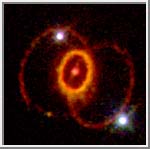 Ring Structure Around Supernova 1987A
Ring Structure Around Supernova 1987A
This striking NASA Hubble Space Telescope picture shows three
rings of glowing gas encircling the site of supernova 1987A, a
star which exploded in February 1987.
Though all of the rings appear inclined to our view (so that
they appear to intersect) they are probably in three different
planes. The small bright ring lies in a plane containing the
supernova, the two larger rings lie in front and behind it.
The rings are a surprise because astronomers expected to see, instead, an hourglass shaped bubble of gas being blown into space by the supernova's progenitor star (based on previous HST observations, and images at lower resolution taken at ground-based observatories). One possibility is that the two rings might be "painted" on the invisible hourglass by a high-energy beam of radiation that is sweeping across the gas, like a searchlight sweeping across clouds. The source of the radiation might be a previously unknown stellar remnant that is a binary companion to the star that exploded in 1987.
The supernova is 169,000 light years away, and lies in the dwarf
galaxy called the Large Magellanic Cloud, which can be seen from
the southern hemisphere.
(Courtesy of Dr. Christopher Burrows, ESA/STScI, and NASA)
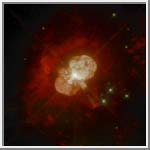 Eta Carinae Star
Eta Carinae Star
Eta Carinae has a mass of approximately 150 times that of the
sun, and is about 4 million times brighter than our local star,
making it one of the most massive and most luminous stars known.
It is highly unstable, and prone to violent outbursts.
The last of these occurred in 1841, when despite its distance
(over 10,000 light years away) Eta Carinae briefly became the
second brightest star in the sky.
The picture is a combination of three different images taken in red, green, and blue light. The ghostly red outer glow surrounding the star is composed of the very fastest moving of the material which was ejected during the last century's outburst. This material, much of which is moving more than two million miles per hour, is largely composed of nitrogen and other elements formed in the interior of the massive star, and subsequently ejected into interstellar space.
The bright blue-white nebulosity closer in to the star also
consists of ejected stellar material. Unlike the outer
nebulosity, this material is very dusty and reflects starlight.
The new data show that this structure consists of two lobes of
material, one of which (lower left) is moving toward us and the
other of which (upper right) is moving away. The knots of
ejected material have sizes comparable to that of our solar
system.
(Courtesy of J. Hester/Arizona State University, NASA)
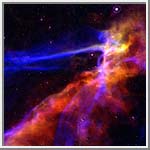 Cygnus Loop Supernova Blast Wave
Cygnus Loop Supernova Blast Wave
This is an image of a small portion of the Cygnus Loop supernova
remnant, which marks the edge of a bubble-like, expanding blast wave
from a colossal stellar explosion, occurring about 15,000 years ago.
The supernova
blast is slamming into tenuous clouds of insterstellar gas. This
collision heats and compresses the gas, causing it to glow. The shock
thus acts as a searchlight revealing the structure of the interstellar
medium.
The image shows the blast wave overrunning dense clumps of gas, which despite HST's high resolution, still defy resolution. This means that the clumps of gas must be small enough to fit inside our solar system, making them relatively small structures by interstellar standards. A bluish ribbon of light stretching left to right across the picture might be a knot of gas ejected by the supernova; this interstellar "bullet" traveling over three million miles per hour (5 million kilometres) is just catching up with the shock front, which has slowed down by ploughing into interstellar material.
The Cygnus Loop appears as a faint ring of glowing gases about three
degrees across (six times the diameter of the full Moon), located in
the northern constellation, Cygnus the Swan. The supernova remnant is
within the plane of our Milky Way galaxy and is 2,600 light-years away.
(Courtesy of J.J. Hester (Arizona State University), NASA)
 Spiral Galaxy M51
Spiral Galaxy M51
This image of the core of the nearby spiral galaxy M51, taken with the
Wide Field Planetary Camera shows a striking, dark "x" silhouetted
across the galaxy's nucleus. The "x" is due to absorption by dust and
marks the exact position of a suspected black hole which may have a
mass equivalent to one million stars like the Sun. The darkest bar may
be an edge-on dust ring which is 100 light-years in diameter. The
edge-on torus not only hides the black hole and accretion disk from
being viewed directly from Earth, but also determines the axis of a jet
of high speed plasma and confines radiation from the accretion disk to
a pair of oppositely directed cones of light, which ionize gas caught
in their beam. The second bar of the "x" could be a second disk seen
obliquely, or possibly rotating gas and dust in M51 interacting with
the jets and ionization cones.
(Courtesy of AURA/STScI, NASA)
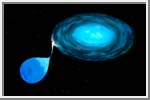 X-ray Burster In Globular Cluster NGC6624
X-ray Burster In Globular Cluster NGC6624
This is an illustration of a double star system at the heart of the
globular cluster NGC 6624, located approximately 28,000 light-years
away in the constellation Sagittarius. The star is a source of powerful
bursts of X-ray emission. The Hubble Space Telescope recently detected
the ultraviolet light from hot disk of gas within the binary system,
thereby identifying its optical component.
One member of the binary is a neutron star, an extremely dense and compact corpse of a massive star that exploded long ago. The neutron star is slowly devouring its larger but less-massive white-dwarf star companion, seen at lower left. Tidal forces from the neutron star's intense gravitation pull stretch the dwarf into an egg-shape. (A white dwarf is the remnant of a burned out Sun-like star.) Gas pulled from the dwarf flows across a narrow accretion bridge and then smear out into a swirling disk.The energy released by the continuous infall of gas onto the neutron star produces the steady X-ray emission. This gusher of radiation heats temperatures greater than 100,000 degrees Fahrenheit. The infall also supplies fuel for sporadic, intense X-ray bursts. These occur when enough gas accumulates on the surface of the neutron star to ignite spontaneously, creating an enormous nuclear fusion bomb. For a few seconds, the outburst abruptly outshines the usual steady X-ray emission.
The stars complete an orbit about each other every eleven minutes,
making this the fastest binary system known. The stars are only 100,000
miles apart, or less than half the distance between Earth and the
Moon.
(Courtesy of Dana Berry/STScI)
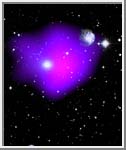 Rosat Observes Hot Gas in a Small Galaxy
Rosat Observes Hot Gas in a Small Galaxy
This image shows a visible light picture of a three galaxies known as NGC 2300 group,
combined with a false-color image (magenta), taken in X-ray light with
the ROSAT satellite.
The x-ray image, taken on April 25-27, 1992, shows that the small group
of galaxies is immersed in a huge cloud of hot gas, about 1.3 million
light-years in diameter. Astronomers estimate that the cloud has a mass
equal to 500 billion times that of the Sun, and is at a temperature of
about 10 million kelvins (about 18 million degrees Fahrenheit).
Although such gaseous material has previously been seen in rich
clusters of galaxies, this is the first time such a hot medium has been
found in a small group that is typical of most clusters in the
universe.
The existence of this gaseous envelope allows astronomers to measure
the total mass of the system. The surprising result is that the total
amount of material in the group is much larger than the sum of the mass
of the hot gas and the stars in the galaxies. This means that a
substantial amount of invisible "dark matter" envelops the system,
keeping the hot gas contained.
The NGC 2300 group is located about 150 million light-years from Earth
in the direction of the northern circumpolar constellation Cepheus.
(Courtesy of NASA)
